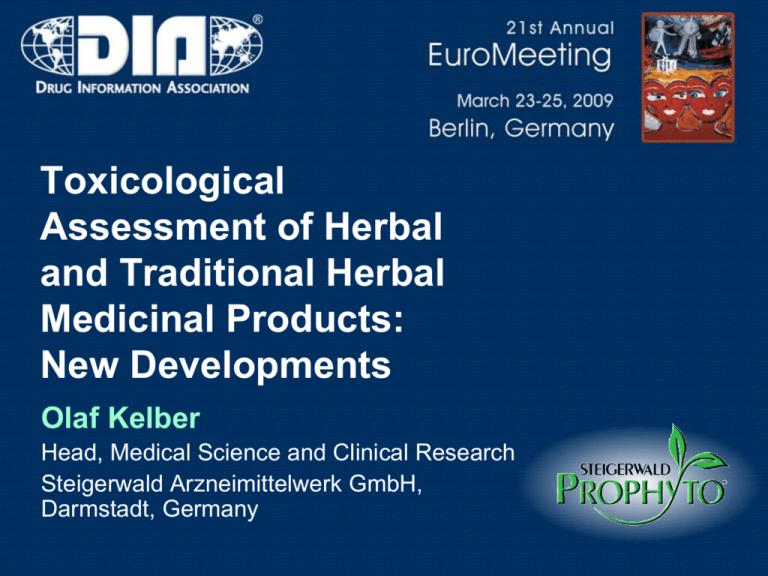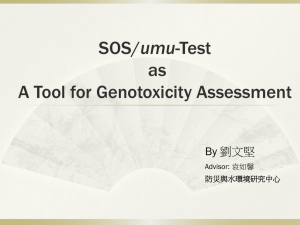
Toxicological
Assessment of Herbal
and Traditional Herbal
Medicinal Products:
New Developments
Olaf Kelber
Head, Medical Science and Clinical Research
Steigerwald Arzneimittelwerk GmbH,
Darmstadt, Germany
Overview / Content
New Developments, Literature Overview
From ICH to Tradition:
New European Regulations in Toxicology
The European Herbal Medicines Directive
Could it have saved the lives of Romeo and Juliet?
(Routlege PA, Drug safety : an international journal of medical toxicology and drug experience; VOL: 31 (5); p. 416-8 /2008)
The New HMPC Genotoxicity Guideline
Which studies to conduct?
News from Herbal Genotoxicity
The Example of the Collaborative Genotoxicity Study Project of the
Kooperation Phytopharmaka – a surprising success
Perspectives
2
New developments - Literature Overview
New developments - view of the scientific literature
Search in DIMDI
(All toxicological databases)
Query: herb? toxic? medic?
from 2008-2009
Total No. 483 hits
Manual Check for
relatedness 90 hits
3
New developments - Literature Overview
Search in DIMDI, results:
Theme
Toxicology,
general
Hepatotoxicity
Other ARs
Heavy Metal
toxicity
Sum
Number
36
28
19
7
90
Low number of papers,
no dynamic field of research
Detallied view necessary
4
New developments - Literature Overview
Search in DIMDI, results:
Theme
Toxicology,
general
Hepatotoxicity
Other ARs
Heavy Metal
toxicity
Sum
Number
36
28
19
7
90
Toxicology, general
- Preclinical and clinical toxicological studies
- Includes reviews (e.g. on ginger), in vitro studies
- Mainly Indian Medicine, TCM
- Also products for veterinary use (dogs, chickens)
5
New developments - Literature Overview
Search in DIMDI, results:
Theme
Toxicology,
general
Hepatotoxicity
Other ARs
Heavy Metal
toxicity
Sum
Number
36
28
19
7
90
Hepatotoxicity
- Mainly reviews, only few case reports or studies
- Incl. TCM, Indian Medicine, Nutraceuticals, Slimming Aids,
Contaminated products (e.g. by Bacteria), Insufficiently
defined products and reactions
6
New developments - Literature Overview
Search in DIMDI, results:
Theme
Toxicology,
general
Hepatotoxicity
Other ARs
Heavy Metal
toxicity
Sum
Number
36
28
19
7
90
Other Adverse Reactions
- Incl. reviews covering also chemically defined
preparations
- Preparations from TCM, Korea, Singapore, Ayurveda
- Incl. Nutraceuticals (e.g. caffeine intoxication), Kava,
Aristolochic acid, Black cohosh, Pyrroizidine alkaloids
7
New developments - Literature Overview
Search in DIMDI, results:
Theme
Toxicology,
general
Hepatotoxicity
Othter ARs
Heavy Metal
toxicity
Sum
Number
36
28
19
7
90
Heavy Metal Toxicity
- Mainly reviews of contaminations
- Preparations from India and the US
8
New developments - Literature Overview
Search in DIMDI, results:
Theme
Toxicology,
general
Hepatotoxicity
Other ARs
Heavy Metal
toxicity
Sum
Number
36
28
19
7
90
Summary
- Mainly reviews
- Mainly Non-European preparations
- No new trends or surprises
9
New developments - Europe
EU Commission
Overview of risk
assessment
methodologies,
Opinion paper
published
January 2009
Critical
assessment
of methods
10
New developments - Europe
EU Commission
Overview of risk
assessment
methodologies,
Opinion paper
published
January 2009
Also thematizes
limitations of
methods
11
From ICH to Tradition
The ICH Toxicity Guidelines
Framework for the study of NCEs
Created for the development of NCEs
Substances with unknown risk profile
Toxicological studies precede the studies
“first in man” resp. the market launch
12
From ICH to Tradition
ICH Guidelines
Safety Guidelines
S1 Carcinogenicity
S2 Genotoxicity
S3 Toxico-/Pharmacokinetics
S5 Reproductive Toxicity
S7 Pharmacology
S8 Immunotoxicology
13
From ICH to Tradition
ICH Guideline M 3:
14
From ICH to Tradition
Example for a
toxicological
assessment plan for
a WEU preparation:
High use of
resources and
time (e.g. 7 years),
no adequate
improvement of
benefit-risk ratio
15
From ICH to Tradition
THMPs and WEU HMPs
Long-standing experience of use in the population
Often clinical studies, covering clinical endpoints
(including acute and chronic tolerability in man)
Substances with (more or less) well known
pharmacological and toxicological profile
Toxicological studies follow the use “first in man”
resp. the market launch.
16
The EU Herbal Medicines Directive
Aim: Enable free trade within the EU
17
The EU Herbal Medicines Directive
Aim: Protection of public health
CONFERENCE PAPER
Drug Safety 2008:31(5):416-418
The European Herbal
Medicines Directive
Could it Have Saved the Lives of Romeo and Juliet?
Philip A. Routledge
Department of Pharmacology, Therapeutics and Toxicology, Wales College of Medicine, Heath
Park, Cardiff, UK
18
.
The EU Herbal Medicines Directive
Aim: Protection of public health
CONFERENCE PAPER
Drug Safety 2008:31(5):416-418
The European Herbal
Medicines Directive
Could it Have Saved the Lives of Romeo and Juliet?
Philip A. Routledge
Department of Pharmacology, Therapeutics and Toxicology, Wales College of Medicine, Heath
Park, Cardiff, UK
.
Conclusion:
No, as in this case, not lack in toxicological data, but lack in
communication was causative for death.
19
The EU Herbal Medicines Directive
Report on the experience acquired (from 29.9.2008)
20
The EU Herbal Medicines Directive
Report on the experience acquired (from 29.9.2008)
Genotoxicity data on a case-by case basis
21
The HMPC Genotoxicity Guideline
In effect
01.12.2008
22
The HMPC Genotoxicity Guideline
Scope:
“For many herbal substances/preparations,
contained in well established or traditional herbal
medicinal products (HMPs), an adequate safety
profile may be confirmed by their documented
history of medicinal use.
However, the complete lack of some specific nonclinical studies (e.g. genotoxicity studies) may
present a safety concern because important
questions relating to product safety would remain
unanswered.”
23
The HMPC Genotoxicity Guideline
“Pragmatic framework on how to assess the
potential genotoxicity of HMPs”,
Stepwise test strategy:
1. Ames test
2. In case of positive results: mammalian cell assay
3. In case of another positive result: in vivo
genotoxicity tests.
Negative results progressing to the next
test step is not required.
24
The HMPC Genotoxicity Guideline
Step 1: The Ames Test
25
The HMPC Genotoxicity Guideline
Step 2: The Mouse
Lymphoma Assay
Assay in L5178Y
mouse lymphoma
cells
26
The HMPC Genotoxicity Guideline
Step 3: The
In Vivo Test
Mouse lymphoma
assay in bone marrow
or peripheral blood
cells
27
The HMPC Genotoxicity Guideline
Summary
• Pragmatic approach
• Tests not contributing to a risk reduction in the
patient are minimized
• In case of lack of specific concern still without
relevant benefit for the patient
• Still a considerable burden in case of herbs of low
economic importance
Importance of a collaborative approach
28
The HMPC Concept Paper on
Genotoxicity Testing
Bracketing
and
Matrixing
as approach to
collaborative
research
Testing of extremes
of extraction solvent
polarity for covering
the whole range
of preparations
29
Genotoxicity Testing: Collaborative Approach
Example:
Genotox Project initiated by
Kooperation Phytopharmaka
Bonn, Germany
Scientific Society active in the field
of herbal medicines
www.koop-phyto.org
30
Genotoxicity Testing: Collaborative Approach
Aim of the project:
- To provide pharmaceutical companies with
state of the art genotoxicity data for
registration of Herbal and Traditional Herbal
Medicinal Products
- To provide an economic way of conducting
trials, using the advantages of a bracketing
and matrixing concept in a collaborative
approach
31
Genotoxicity Testing of Koop. Phyto.
Bracketing and matrixing concept:
Example: Hops (Humuli lupuli strobuli)
Extracts tested:
polar
Water
Methanol 45 %
Ethanol 90 %
unpolar
Heptane
These solvents cover the whole range of polarity.
Extrapolation to the whole range of extracts
Extrapolaton also to drug powder preparations
32
Genotoxicity Tests of Koop. Phyto.
- Coordinated collaborative approach
- Conduction in cooperation with GLP
certified toxicological laboratories
- Methods according to all current guidelines
(including OECD, ICH, EMEA)
33
Genotoxicity Tests of Koop. Phyto.
Step 1: Ames test
- Bacterial reverse mutation test, developed by
Bruce Ames, Univ. of California, Berkeley, 1970ff.
- Salmonella typhimurium strains with defects in
gene(s) involved in histidine synthesis Growth
depends on external histidine
- Mutations lead to accidental repair of defect gene
Histidine independent growth
- Mammalian hepatic metabolism is mimicked with
S9 Mix (enzyme fraction from rat liver)
34
Genotoxicity Tests of Koop. Phyto.
Ames test
OECD Guideline 471:
Conduction in 5 different strains
differing in susceptibility to different mutagens
35
Genotoxicity Tests of Koop. Phyto.
Figure: Counting of colonies using
the Petri Viewer Mk2 (Perceptive
Instruments) and the software
program Ames Study Manager
Negative
Positive
Photographs: A. Sokolowski,
Harlan RCC, Roßdorf, Germany
Ames test
Control:
TA 100
TA 1535
E. coli
36
Genotoxicity Tests of Koop. Phyto.
Step 1: Ames test
- For several herbal preparations, positive results
in Ames tests could not be reproduced in
mammalian cell assays or in vivo assays
- These false positive results have been attributed
mainly to the quercetin content of these herbal
preparations
- Therefore the usefulness of the Ames test for
testing herbal preparations has been questioned.
(Okpanyi S.N. et al., Arzneim.-Forsch./Drug. Res. 1990, 40 (II)): 851-855)
37
Genotoxicity Tests of Koop. Phyto.
Herbal drugs tested:
- Artichoke
- Bittersweet
- Stinging nettle
- Marshmallow
- Gingko
- Ginseng
- Hops
- St. John´s wort
- Garlic
- Caraway
- Pumpkin oil
- Pine oil
-
Milk thistle
Melissa
Mistle
Passiflora
Primrose
Rosmary
Horse Chestnut
Liquorice
Thyme
Whitethorn leaves and flowers
Whitethorn fruits
Devils claw
38
Genotoxicity Tests of Koop. Phyto.
Results, example:
Negative results for
a St. John´s wort
extract.
Validated by independent testing in a
second laboratory.
39
Genotoxicity Tests of Koop. Phyto.
Conclusions:
The project has broadened the knowledge about the
safety of important herbs used in Europe and allows to
meet current regulatory requirements.
The project unexpectedly has also shown that the safety
profile of some herbs, previously under discussion, has
to be re-rated as safe when tested by modern validated
methods.
40
Perspectives
.
41
Perspectives
Harmonization with the US?
Wu et al., Food Chem Toxicol 2008, 46:2606-2610
2008: FDA authorizes its first HMP (Veregen®)
42
Perspectives
Harmonization with the US?
Wu et al., Food Chem Toxicol 2008, 46:2606-2610
Demands of FDA in large parts identical with
ICH guidelines for NCEs
From an European perspective,
adequate acceptance of traditional
or well established use is questionable
43
Perspectives
New developments in the assessment of
toxicological data and case reports?
• Dose as a key issue
• Critical consideration of pharmaceutical quality
• Priority for clinical data and in vivo toxicological
data, use of in vitro data only where adequate
• Approach of transparent pragmatism, respecting
traditional and well established use also in subgroups of patients (e.g. children), and by physicians
44
Thank you for your attention!
.
45
Disclaimer
The views and opinions expressed in the following PowerPoint
slides are those of the individual presenter and should not be
attributed to Drug Information Association, Inc. (“DIA”), its
directors, officers, employees, volunteers, members, chapters,
councils, Special Interest Area Communities or affiliates, or any
organization with which the presenter is employed or affiliated.
These PowerPoint slides are the intellectual property of the
individual presenter and are protected under the copyright laws of
the United States of America and other countries. Used by
permission. All rights reserved. Drug Information Association, DIA
and DIA logo are registered trademarks or trademarks of Drug
Information Association Inc. All other trademarks are the property
of their respective owners.
46









